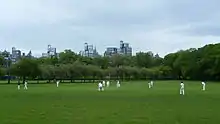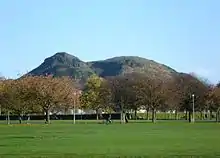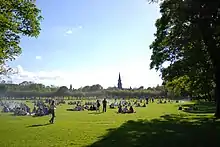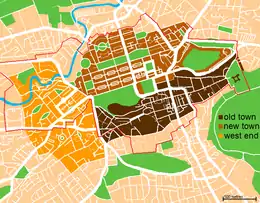The Meadows, Edinburgh
The Meadows is a large public park in Edinburgh, Scotland, to the south of the city centre.[1]

It consists largely of open grassland crossed by tree-lined paths, but also has a children's playground,[2] a croquet club,[3] tennis courts[4] and recreational sport pitches.[5] It is bordered by the University of Edinburgh's George Square campus, the Gordon Aikman Lecture Theatre and the Quartermile development on the site of the old Edinburgh Royal Infirmary to the north and Marchmont to the south.[1] To the south-west it becomes Bruntsfield Links where there is a free, public pitch and putt golf course.[5]
History


The Meadows is historically common land and although now in the care of the council is technically in the ownership of the community itself. It was used for unhindered common grazing until at least 1920 and only with the demise of this need did it become exclusively "a park".[6]
The Meadows originally contained a loch, known as the "burgh loch" or, later, the "South Loch". It covered much of the area bounded in the east by Hope Park Terrace and in the west by the point where Melville Drive becomes Brougham Street, and in the south by Melville Drive and in the north by the site later occupied by the Old Royal Infirmary, a total of 63 acres (250,000 m2). The loch drained from east to west, where the burn known as the Loch-rin was fitted with a sluice gate to prevent the water from draining out. It is from this burn that the street names Lochrin Buildings and Lochrin Place in Tollcross derive. Until Edinburgh's first piped water supply from Comiston arrived in 1621, the loch provided much of the town's drinking water.
It was partially drained in the mid-17th century and for a time named Straiton's Loch or Straiton's Park after the burgess who tried to improve the area. In 1722 Sir Thomas Hope, 8th Baronet Hope of Craighall (c. 1681–1771), an agricultural improver and politician, ordered more drainage work, making the marshy land into a park with a path round the edge, hedges, avenues of lime trees, drainage canals and a summer house.[7][8] The central tree-lined path known as Middle Meadow Walk followed, and for several decades maps labelled this area as "The Meadows or Hope Park". It is the traditional practice ground of the Royal Company of Archers, whose meeting-place is nearby. In 1827 an Act of Parliament protected the Meadows from being built upon.
Though animals were grazed there and notable Edinburgh citizens are known to have walked there, there was no full right of public access until the middle of the 19th century when new paths were gradually added, criss-crossing the park. An exception to city council rules against building on the land was allowed for the temporary large glass pavilion of the 1886 International Exhibition of Industry, Science and Art.[9] The whale's jawbones forming an arch over the Meadows path called Jawbone Walk originally formed the display stand of the Zetland and Fair Isle Knitters Association. Having been severely affected by weathering, the Arch was removed in 2014 for restoration.[10]



In the 1870s the Meadows became an important venue in the early development of football in Edinburgh. Amongst the numerous fledgling teams using the Meadows were Heart of Midlothian F.C. and Hibernian F.C., later to become the city's preeminent sides, and the first derby match between them was played there on 25 December 1875.[11] Although a modern plaque has been placed near Whalebone Arch to commemorate the event, the main pitch was on the eastern fringe of the park, running from east to west, parallel with the Boroughloch Brewery.
The Second World War brought more than 500 allotments to the east end of the Meadows as part of the effort to make the nation more self-sufficient in food.[12] By 1950 many local residents wanted the area re-turfed, but it was 1966 before the last signs of vegetable cultivation were removed.
In the late 1960s, plans to complete a "flyover" over the Meadows for a trunk road were defeated.[12]
Events
The most significant event in the history of the Meadows was the International Exhibition of Industry, Science and Art in 1886, during which a high percentage of the park was built over.
The size and prominence of the park has led to many sporting events being hosted in the summer. Every March, nearly 1,000 runners take part in the annual Meadows Marathon, a charity half marathon and five-kilometre fun run, and, from 2013, a full marathon as well.[13] Between 1975 and 2005 the Meadows Festival was held on the first weekend in June, returning from 2008 onwards.[14] The Meadows is one of the host venues for the Edinburgh Festival, such as the annual Fringe Sunday. It is also the venue for the start and finish of the Edinburgh Moon Walk, an annual event involving 12,000 walkers raising money for breast cancer research and treatment. Being one of the few flat stretches of open land in the central area of the city, it is occasionally host to public protests and rallies, including the 225,000-strong Make Poverty History march on 2 July 2005.[15] Circuses also frequently visit the Meadows around June.[5] In 2013, a Giant chess set was placed at the children's play area on the east side.[16] In 2018 the Danish storyteller Svend-Erik Engh held a series of events called Stories under the Tree, storytelling under the Sycamore Tree next to Prince Albert Victor Sundial. These events were inspired by Historier under Bøgen, storytelling in Kings Garden, Copenhagen.
Botanical
The Meadows remains noteworthy for its mature elms, though Dutch elm disease has taken a gradual toll over the years. Most of the survivors (2019) are wych elm and Huntingdon Elm,[17] but there are also specimens of the variable Field Elm. Some replanting with disease-resistant hybrids like Ulmus 'Regal' and Ulmus 'Columella' has begun.[18]
 Ulmus japonica by Coronation Walk, The Meadows, 1989[19]
Ulmus japonica by Coronation Walk, The Meadows, 1989[19] Semi-pendulous Ulmus, form resembling Downton Elm, The Meadows, 1989
Semi-pendulous Ulmus, form resembling Downton Elm, The Meadows, 1989 Field elm cultivar 'Pseudo-Viminalis', The Meadows, 1989
Field elm cultivar 'Pseudo-Viminalis', The Meadows, 1989 Scotch elm, The Meadows, 1989
Scotch elm, The Meadows, 1989 Dutch elm, The Meadows, 1989
Dutch elm, The Meadows, 1989
References
- "The Meadows – Edinburgh Guide". www.edinburghguide.com.
- Evans, Melanie. "Edinburgh Play Park in the Meadows".
- "Meadows Croquet Club, Edinburgh". www.meadowscroquet.org.uk.
- "Meadows City Tennis Club – Edinburgh". Meadows City Tennis Club.
- The Meadows, Edinburgh
- Ward Lock travel guide to Edinburgh and District 1925
- "Friends of the Meadows and Bruntsfield Links". www.fombl.org.uk.
- Eileen Stewart (2015). Honest George. BookBaby. p. 73. ISBN 978-1-4835-5019-0.
- "The Meadows, Edinburgh".
- "Jawbone Arch set for removal and restoration". City of Edinburgh Council. 18 July 2014. Retrieved 21 August 2016.
- Speed, David; Smith, Bill; Blackwood, Graham (1984). Heart of Midlothian Football Club: A Pictorial History 1874–1984. Heart of Midlothian F.C. plc. ISBN 0-9510124-1-X. ().
- "The Meadows". fantasybob.blogspot.co.uk.
- "New Year intentions to see Meadows Marathon numbers soar – News – Edinburgh – STV".
- "Meadows Festival – Edinburgh Guide". www.edinburghguide.com.
- Make Poverty History – Media – News Archive
- "Giant chess board bid to fight child obesity". news.scotsman.com. 17 April 2013. Retrieved 7 August 2013.
- "Friends of the Meadows and Bruntsfield Links". www.fombl.org.uk.
- 'Regal' in Edinburgh: nomorepencils.com/dutch-elm-disease-in-edinburgh/; fombl.org.uk/nl4.pdf; fombl.org.uk/nl5.pdf
- Tree labelled Japanese elm by 'Friends of the Meadows and Bruntsfield Links', in Coronation Walk, The Meadows, Edinburgh: fombl.org.uk
External links
| Wikimedia Commons has media related to The Meadows, Edinburgh. |
- Meadows Marathon – Annual charity Half Marathon and 5 km fun run.
- Friends of The Meadows and Bruntsfield Links (contains Java applet)
